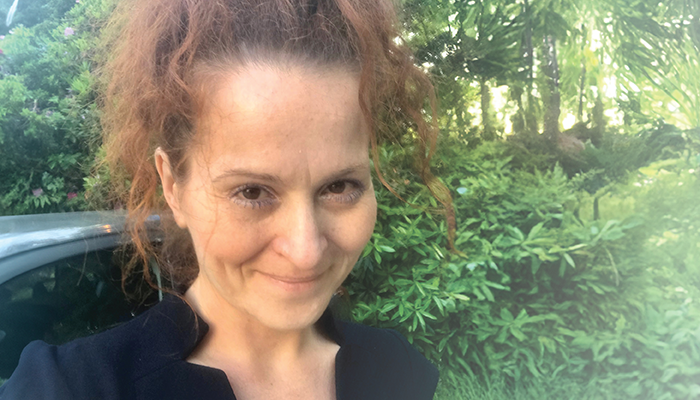
Pola Goldberg Oppenheimer (Credit: Headshot supplied by author)
Traumatic brain injury (TBI) is a leading cause of morbidity worldwide and incidence is rising – but point-of-care diagnosis is tricky. Keen to offer an alternative, a group of researchers from the University of Birmingham have designed EyeD – a type of eye-safe laser technology that uses Raman spectroscopy to diagnose TBI. Pola Goldberg Oppenheimer, Professor in Microengineering and Bionanotechnology at The University of Birmingham, tells us more (1).
Why do we need more point-of-care diagnostic methods for traumatic brain injury?
By 2030, the World Health Organization (WHO) estimates that TBI will become the third largest cause of neurological disability and deaths worldwide. In the UK, there is approximately one head injury admission every three minutes, and two million are living with long-term disabilities – placing a major burden on the NHS.
When diagnosing TBI, a decision must be made rapidly – making it notoriously hard to diagnose in point-of-care settings. Such a high pressure situation often leads to incorrect patient management, and increases the chance of the patient suffering cognitive or physical impairment. Existing diagnostic methods are woefully inadequate – they are either highly invasive, not sensitive enough, or have long waiting times. Point-of-care technology for TBI does not currently exist. There is, therefore, an urgent need for new technologies to achieve timely intervention through rapid and accurate diagnostics.
Please describe how EyeD works…
Firstly, we developed a bespoke artificial neural network algorithm – self-optimizing Kohonen index network (SKiNET) – as a generic framework for multivariate analysis that provides dimensionality reduction, feature extraction, and multiclass classification as part of a seamless interface. Using SkiNET, we classified TBI from spectral data and established validation on mouse eyes by detecting and classifying tissue-specific signatures of each anatomical layer on eye sections. SKiNET software integrated in the final device acts as a decision support tool where interpretation of Raman data will be automated and will not require specialist support – dramatically improving the speed and cost of diagnosis.
In ex-vivo murine retina, we have demonstrated feasibility of Raman in differentiating TBI from healthy controls with a high degree of accuracy across a range of injury severities. This was in agreement with measurements from brain data, which separates according to injury state and observed spectral changes associated with cardiolipin and metabolic distress.
Further experiments performed on pig eyes, using 633 nm excitation wavelength, detected molecular fingerprints of TBI neuromarkers. We observed an apparent enhancement of high wavenumber bands, and data displayed a clear separation between control and TBI groups using SKiNET.
What are the benefits of using Raman spectroscopy over more conventional methods of diagnosing TBI?
Our device allows early diagnosis of TBI by directly assessing acute distress changes in living neuroretinal or optic nerve tissue. It provides a non-invasive means to directly interrogate the central nervous system and, by using Raman spectroscopy, we can interpret optical signals from the retina/optic nerve. This non-contact approach ensures instant and effective assessment results.
The main advantage of measuring changes in optical biomarkers is that it can be done quickly and noninvasively. A compact Raman spectrometer can probe the posterior segment of the eye to detect TBI at the point-of-care and monitor injury evolution in real-time.
Among the optical techniques, Raman offers the richest and most sensitive spectroscopic discrimination. Additionally, Raman spectra define chemical fingerprints that are uniquely determined by the underlying molecular constituents.
How could your spectroscopic technique benefit healthcare professionals and pathologists globally?
Our portable device is designed to detect neurotrauma at point-of-care (for example, roadside, pitchside, or an austere combat environment), where no expert evaluation is currently immediately available. The creation of point-of-care technology would reduce mis-triage of injury severity, save on healthcare costs, and improve outcomes by guiding early management. By using our spectroscopic technique, onsite doctors and ambulance crew can provide timely and cost-effective diagnosis and triage. Rapid diagnosis in the early-clinical phase will lay the platform for a range of improvements in personalized medicine and management, while reducing strain on the healthcare system.
We believe the final device would have two distinct but complementary uses. First, in the prehospital space, eyeD will improve triage of TBI as mild, moderate, and so on, supporting decision-making by prehospital providers to reduce referral to hospital care, reducing the number of ED visits. Second, in polytrauma and severe TBI, it would enable early-intervention and the correct triage of patients to the most appropriate destination. The economic benefits to healthcare – in terms of resource-reduced demand – are clear and should support adoption and mitigate the relatively low costs of the investigation in comparison to ED assessment, CT imaging, and admission.
Could you tell us more about the “eye phantom” you engineered?
The eye phantom was developed to test whether the eye could be used with a collimated laser beam incident on the cornea. It can be further exploited for research and development of new pathways as a synthetic model where Raman spectra through an eye-like lens will be acquired on model biological samples, mounted in the eye, to optimize resolution and optical throughput. Samples, such as hydrogels and artificial CSF, could be studied with model markers. The eye phantom could be particularly useful for animal model studies, and contribute towards research focused on identifying changes in brain biochemistry or function caused by either acute or chronic neurological diseases.
